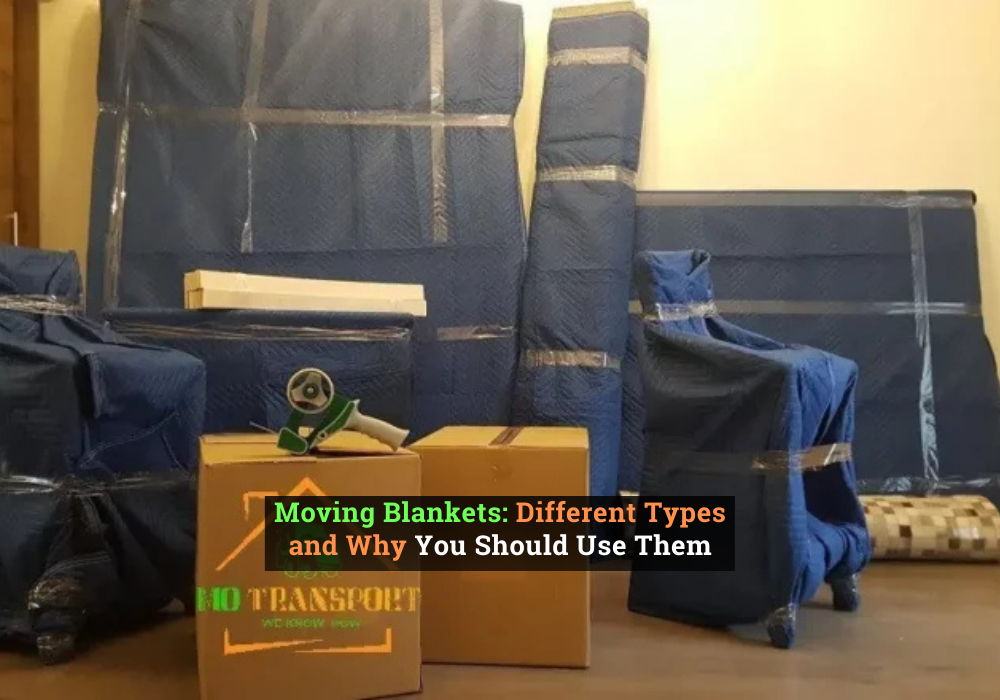Moving blankets are protective coverings used during moves to shield furniture and other valuable items from damage. Unlike regular blankets, which are often made from softer materials and designed for warmth, moving blankets are constructed from heavy-duty materials like cotton, polyester, or a combination of both, providing extra durability and padding. They come in various types, including standard, quilted, and cushioned varieties, each offering different levels of protection based on the needs of the move. The benefits of using moving blankets include preventing scratches, minimizing the risk of impact damage, and securing items during transport. Alternatives such as towels, bubble wrap, or cardboard sheets can be used, but they do not offer the same level of comprehensive protection as moving blankets. Moving blankets can be used for home, office, or piano moves, as well as for other special items that require extra care. In Bristol, moving blankets can be rented from local transport services such as MO Transport, and the cost typically ranges from £5 to £10 per blanket, depending on the size and duration of the rental.
What is a moving blanket?
A moving blanket is a specialized protective covering designed to shield furniture, appliances, and other valuables during a move. Unlike regular blankets, which are generally soft and made for comfort, moving blankets are constructed with heavy-duty materials such as polyester, cotton, or a combination of both. These materials provide enhanced durability, cushioning, and protection against scratches, dents, and other forms of damage during transportation. Moving blankets often feature quilted stitching, adding extra padding and reducing the risk of items shifting during transit. Their main purpose is to safeguard valuable belongings during moving processes, ensuring that they arrive at their destination in the same condition.
What is the difference between a moving blanket and a regular blanket?
The difference between a moving blanket and a regular blanket lies in their construction, purpose, and materials. A moving blanket is designed specifically for protecting furniture and other valuables during transit. It is made from thick, durable materials such as polyester, cotton, or a combination, often featuring quilted padding for extra cushioning. The primary function of a moving blanket is to prevent scratches, dents, and damage during transportation. In contrast, a regular blanket is typically made from softer fabrics like cotton, wool, or fleece, and its main purpose is comfort and warmth, not protection. Regular blankets lack the density, structure, and durability needed to protect items during a move. Additionally, the quilting and padding found in moving blankets provide more comprehensive coverage and shock absorption, features absent in standard blankets. Thus, while regular blankets may offer minimal protection, they are not a suitable substitute for the robust shielding provided by moving blankets during a move.
What are moving blankets made from and why?
Moving blankets are typically made from materials like polyester, cotton, or a blend of both. These materials are chosen for their durability, cushioning, and ability to protect items during a move.
What types of moving blankets exist?
There are three main types of moving blankets commonly used for relocations:
- Standard Moving Blankets: These are made of polyester or cotton blends, providing basic protection for most furniture and items during a move. They are lightweight yet durable.
- Quilted Moving Blankets: Heavier and thicker than standard blankets, these feature a quilted design for extra cushioning and are ideal for more delicate or valuable items.
- Cushioned Moving Blankets: Designed with additional padding, these blankets offer maximum protection for high-value or fragile items, such as antiques or electronics.
Each type of moving blanket serves a different purpose, ensuring that items are protected according to their fragility and the level of care required during transportation.
What are the main benefits of using moving blankets during a move?
The primary benefits of using moving blankets during a move include protecting your furniture from scratches and dents, cushioning fragile items, and preventing damage from shifting during transit. Moving blankets are designed to offer a durable layer of protection, ensuring that valuables remain in good condition throughout the moving process. They also help secure items in place within the moving truck or van, reducing the risk of objects falling or colliding. Additionally, they can provide insulation against temperature changes during transport. Overall, moving blankets are a reliable, cost-effective solution for safeguarding belongings during any move.
What alternatives can I use instead of moving blankets?
Alternatives to moving blankets include towels, bubble wrap, and cardboard sheets. These materials provide some protection but lack the durability and cushioning of moving blankets.
Are moving pads the same as moving blankets?
Yes, moving pads and moving blankets are the same thing. Moving blankets are thicker and offer more protection, while moving pads are thinner and provide lighter cushioning, typically used for less fragile items.
How do I properly use moving blankets during a move?
To properly use moving blankets during a move, follow these steps:
- Wrap each item: Fully cover furniture or fragile items with a moving blanket to prevent scratches.
- Secure with tape or straps: Use packing tape or moving straps to hold the blanket securely around the item.
- Layer blankets inside the moving truck: Place blankets on the floor of the truck to protect items from shifting or impact.
- Use for stacking: Use blankets between items to prevent direct contact and damage when stacking.
- Cover sharp edges: Ensure any sharp or protruding edges are covered to avoid damage to surrounding items.
Following these steps ensures optimal protection for your belongings during a move, preventing damage and providing extra cushioning.
Are moving blankets only needed for furniture moves?
No, moving blankets are not only needed for furniture moves. They can also protect appliances, electronics, and other valuable items during transportation, providing extra cushioning and preventing damage during a move.
Why should I use moving blankets for an office move?
You should use moving blankets for an office move because they provide essential protection for various types of office equipment and furniture. First, they shield desks, chairs, and filing cabinets from scratches and dents during transportation, preserving the condition of valuable office assets. Second, moving blankets help prevent damage to fragile electronic equipment such as computers, printers, and monitors, which are vital to business operations. Third, these blankets offer additional padding for bulky office items that are difficult to pack in boxes, making them ideal for protecting items that need extra care. Fourth, using moving blankets ensures that sharp edges and corners are covered, reducing the risk of damage to both the items being moved and the walls or floors of the office space. Finally, moving blankets help secure office equipment within the moving truck, minimizing movement during transport and reducing the likelihood of costly damage to your office assets.
Should I use moving blankets for a home move?
Yes, you should use moving blankets for a home move. They offer excellent protection for furniture, appliances, and other valuable household items, preventing scratches, dents, and damage during transport, ensuring your belongings remain safe.
How many blankets do I need for a two-bedroom house move?
For a two-bedroom house move, you will generally need 20 to 25 moving blankets. The exact number depends on the number of large furniture pieces, appliances, and fragile items. For example, if you have more delicate furniture, you may require additional blankets to ensure extra protection. You may also need fewer blankets if you’re moving fewer items or if some are already well-packed or cushioned. Use blankets liberally to safeguard valuable items, but adjust the count based on your specific moving needs.
How many moving blankets do I need for a piano move?
For a piano move, you will typically need 1 to 2 moving blankets. The exact number depends on the size and fragility of the piano. If the piano is upright, one blanket may suffice for basic coverage. For a grand piano or delicate models, two blankets provide extra protection, especially around sharp corners and fragile surfaces. Consider additional padding if the piano is being transported long distances or in difficult conditions. The key is ensuring that every part of the piano is fully covered to prevent scratches and dents during the move.
Are moving blankets available for rent in Bristol?
Yes, moving blankets are available for rent in Bristol from MO Transport, a local moving service provider offering affordable rental options for blankets to protect your items during transit.
How much does it cost to rent moving blankets in Bristol?
Renting moving blankets in Bristol typically costs between £5 to £10 per blanket, depending on the provider and rental duration. For example, at MO Transport, we offer blankets without additional costs, making them a budget-friendly option for securing your belongings during a move.
Can I wash and reuse moving blankets?
Yes, moving blankets can be washed and reused. Most moving blankets are made from durable, washable materials such as polyester or cotton. To clean them, use a washing machine on a gentle cycle with mild detergent. Avoid using bleach, as it can weaken the fibers. After washing, air-dry the blankets or tumble dry on a low setting to preserve their durability. Reusing blankets is a cost-effective and eco-friendly option for multiple moves.

